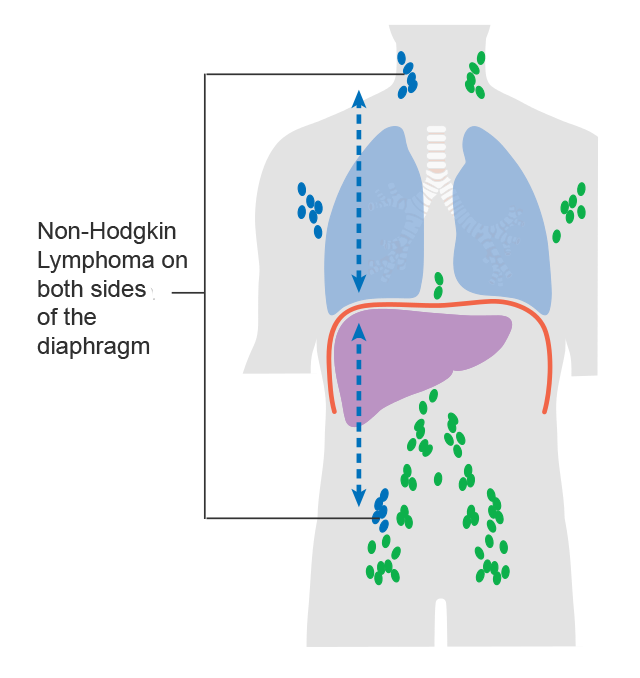- Stage 3 Diffuse Large B-Cell Non Hodgkin Lymphoma Diagnosis
Overview
Diffuse Large B-cell Non-Hodgkin Lymphoma is the most common type of fast growing, Non-Hodgkin Lymphoma. It begins in your B lymphocytes, the white blood cells that help your body fight infection.
Stage 3 Non-Hodgkin Lymphoma is an Advanced Stage of the disease. It involves lymph nodes regions on both sides of the diaphragm and may have also spread to the spleen.
What Tests Will I Need and Why?
Blood tests and imaging such as a CT scan and/or a PET scan are done to understand your general health, confirm your diagnosis and determine your cancer stage.
Tissue analysis in the form of a core needle biopsy or excisional biopsy is typically done. In some cases, a bone marrow biopsy may be needed.
If your treatment team has not already performed tests to determine your cancer’s features, please ask your doctor when these tests will be performed.
Re-read this summary as needed and then tap, “Compare My Treatment Options Now“. Our unique Comparison Page will help you understand your FDA-approved treatment options including, who can help you pay for your treatment, where and how each is given and what side-effects you may experience.

National Institute of Health/ treatment-lymphoma
Recommended Non Hodgkin Lymphoma Cancer Videos

Lymphoma: What Exactly Is It?
Easily Explained for You

Diagnosing Your Cancer
How Does a CT Scan Work?

Diagnosing Your Cancer
How Does a PET Scan Work?

Exercise! You Can Do It
Reducing Side Effects & More
Commonly Searched Questions
What Is Stage 3 Non-Hodgkin Lymphoma?
Source: Cancerresearchuk.org
What’s the survival rate of Stage 3 Non-Hodgkin Lymphoma?
Source: Cancer.gov
What are the symptoms of Stage 3 Non-Hodgkin Lymphoma?
- Swollen lymph nodes in your neck, armpits or groin
- Abdominal pain or swelling
- Chest pain, coughing or trouble breathing
- Persistent fatigue
- Fever
- Night sweats
Source: Cancer.gov
What are the tests used to diagnose Stage 3 Non-Hodgkin Lymphoma?
- complete blood count (CBC) with differential
- blood chemistry studies
- bone marrow aspiration and biopsy
- cytogenetic analysis
- immunophenotyping
- molecular testing
Source: Cancer.gov
What are the risk factors of Stage 3 Non-Hodgkin Lymphoma?
- Older age – Getting older is a strong risk factor for lymphoma overall, with most cases occurring in people in their 60s or older . But some types of lymphoma are more common in younger people.
- Gender – Overall, the risk of NHL is higher in men than in women , but there are certain types of NHL that are more common in women. The reasons for this are not known.
- Family History – Having a first degree relative (parent, child, sibling) with NHL increases your risk of developing NHL.
- Having a weakened immune system
Source: Cancer.gov
What are the treatment of Stage 3 Non-Hodgkin Lymphoma?
- radiation therapy
- chemotherapy
- targeted therapy
- immunotherapy
- plasmapheresis
- stem cell transplant
- surgery
Source: Cancer.gov














